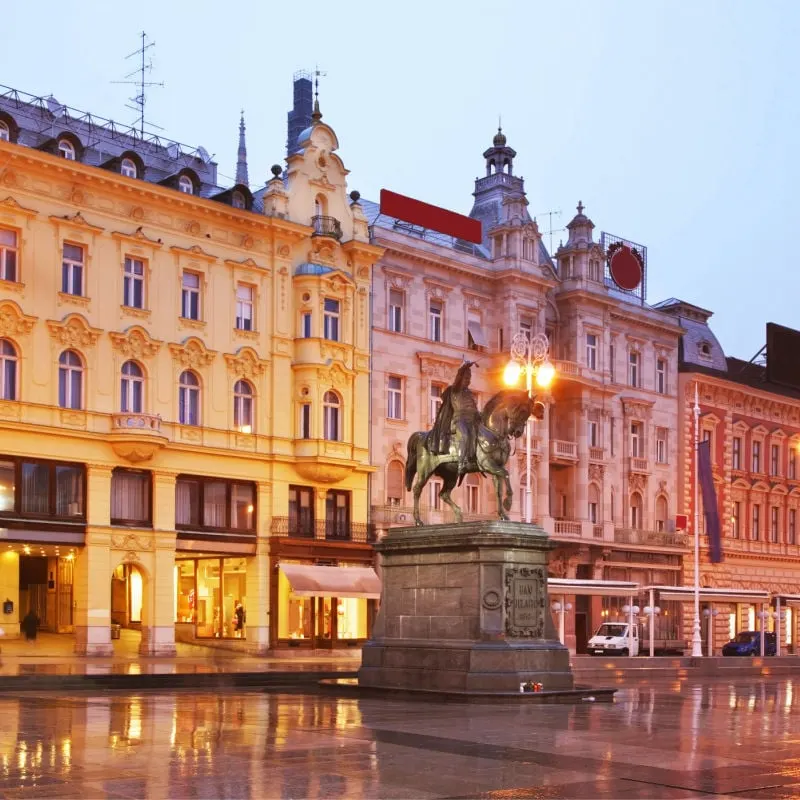Share the article
Last updated
Famous for its beautiful coastline, surrounded by a blue-green Adriatic Sea, its ancient cobbled towns dating back to time immemorial, and a mild subtropical climate, Croatia is one of the most sought after summer destinations in Europe this year.

Although destinations like Dubrovnik and Split are leading booking trends, thanks to their ancient culture and coastal location, Croatia’s capital Zagreb, perhaps the most vibrant city, is still overlooked by most tourists.
But don’t ignore it! It’s perfect for those interested in history, unique cultural experiences and vibrant city life, all on a budget.
It has no beach and it exists in a parallel universe to that of Roman-influenced Dalmatia, but it’s just as incredible and can be much cheaper to visit:
Why is the Croatian Capital Of all places, one of the least visited in the country?


National capitals are usually the most visited cities in a country: take for example Paris, home to the Eiffel Tower and the monumental Louvre, or Rome, with its Colosseum and high concentration of monuments, or London and its monumental bank of the Thames.
Usually they overshadow secondary destinations that have just as much to offer, but short-term tourists won’t go out of their way to visit, for example, French Normandy, full of castles, northern Italian Verona, a kind of ‘mini- Rome’ with its own Colosseum, or the summery peninsula of Cornwall.


In the case of Croatia it is the roles have been reversed: it’s the smaller Adriatic settlements, hundreds of kilometers away from the capital, that have led the way over the years, whether it’s pastel-colored Zadar, up-and-coming Split or the storybook-filled fortress city of Dubrovnik.
Millions of foreigners fly to Croatia every summer, and although they will usually explore the coastline and islands extensively, they bypass the capital altogether, but here’s why they should not have to:
It has beautiful architecture


You might have trouble believing that Zagreb and Dubrovnik are two cities under the same flagbecause they couldn’t be further apart: while the Game of ThronesThe historic harbor with its distinctive character is typically Mediterranean, the former is undisputedly Central European.
Zagreb traces its origins to an 11th-century municipality, which would eventually be incorporated into the Austro-Hungarian Empire, hence its rich medieval heritage and elegant architecture that dominates much of the city center.


What we’re trying to say is: don’t expect to find traditional Dalmatian ocher stone houses with green shutters or narrow cobbled streets; instead you’ll see grand boulevards lined with stately Habsburg buildings and an eclectic mix of baroque art nouveau – and of course modernism.
Zagreb was once one of the largest cities in the former Yugoslavia, a socialist state that existed in southeastern Europe for much of the 20th century, and its suburbs consist of a large number of brutalist apartment buildings and concrete behemoths.
This is a Metropolis with 800,000 inhabitantsfinally.


The city center, on the other hand, is in the realm of cities like Budapest and Vienna, with its wide streets rattled by historic trams, green city parks and a strange palatial complex reminiscent of Zagreb’s imperial days.
The old town is incredibly charming
The Old Town is divided between the lower and upper parts: the Lower Town is centered around the Zagreb Cathedral with two towers and a busy Ban Jelačić Square, flanked by shops and restaurants, while the Upper Town is just its own little picturesque village:


It is guarded by a medieval watchtower, reached by one of the shortest cable cars in the world, which goes just 66 meters uphill, and all the narrow cobbled streets seem to lead to the 13th-century St. Mark’s Church, famous for its glazed tiled roof.
Dating back to the Second World War, the Grič Tunnel is also not to be missed: it is part of the city’s extensive system of underground passages and was once used by residents to reach the city center while protected from shelling, but houses now and then art exhibitions.
If you want to see all the highlights without thinking, you can always try a bike tour! It’s a great way to get it all in and under $50 per person, check it out here.


Among the endless amazing things you can do, there is the Museum of Broken Relationships, in the heart of Uptown, a heartbreaking exhibition of emotionally charged objects associated with former lovers, whether it is a scarf, a teddy bear or a family heirloom.
Zagreb’s museums are really on a whole other level: whether it’s an 80s museum that welcomes visitors in a nostalgic six-room apartment from the Yugoslav era or the equally quirky Museum of the Hangovers, dedicated solely to absurd stories about date nights out, you’re in for high-quality entertainment.
Epic nightlife


Speaking of nightlife, Zagreb’s is probably it wildest, most unhinged all over Croatia: for younger crowds and pumping techno music, Boogaloo is the place to go; for a more industrial warehouse vibe there’s the dingy Depo; for the gays, Rush Bar is all the fun you need on a Friday night.
Berlin still reigns undisputed as the nightlife capital of Europe, but its overlooked counterpart in the Balkans could well come in at a close second, especially when it comes to the edginess of its club scene and the thriving rave culture that is developing.


If you’re looking for a more relaxed experience, Tkalčićeva Street in the Old Town has a great selection of casual cocktail bars and restaurants, where delicious $3 beer––You can’t possibly leave Zagreb without drinking a pint of amber Ožujsko––and $13 meals.
Zagreb is cheaper than the Dalmatian coast
Affordability is another big draw for the occasional tourist willing to trade the Adriatic coast for a city break in Zagreb: on average they spend $40 a day on food, from $44 to $104 on hotels, and less than $10 on local transportation. as based on estimates provided by Budget your trip.


Zagreb doesn’t host the typical Mediterranean crowd, because it isn’t, Mediterranean, and as a result room prices are often fairer: a bed in a shared dormitory costs as cheap as $21 this season, while a private, central Airbnb will doing. put you back a moderate $63 per night.
Further from the old town is the well-rated three-star Tomislavov Dom, which costs $66 per night to book, while Hotel Croatiauptown, within walking distance of St. Mark’s Church and the Museum of Broken Relationships, is only $10 more expensive including breakfast.
How to get to Zagreb this summer?


Despite being the Croatian capital, Zagreb does not operate flights from the United States: it has lost the status of a transatlantic hub to Dubrovnik, where United Airlines has been operating since 2021, offering flights to and from Newark.
So while you can fly non-stop to Croatia this summer you can only fly to Dubrovnik, at the very end of the Dalmatian coast, more than 600 kilometers south of Zagreb. When you think about it, it’s no wonder that Americans bypass the capital altogether.


However, you can easily catch a connecting flight to Zagreb from Dubrovnik with Croatia Airlines: there are several departures per day in summer, and one-way tickets on this route start from $63 at the cheapest rate (normally excluding checked baggage). (check it out Google Flights here)
Alternatively, you can fly from the United States to a major European hub such as Frankfurt, Paris or London, and from there fly on to Zagreb: this will give you a wider choice of airlines, such as Lufthansa, AirFrance and British Airways, and potentially more attractive Prices.


If you are already in Central or Eastern Europe, Zagreb can easily be reached by train or bus from:
- Ljubljana in Slovenia (1h44)
- Budapest in Hungary (3h39)
- Vienna in Austria (4h21)
- Belgrade in Serbia (4 hours)
Both Vienna and Belgrade offer non-stop flights of the United States.


✈️Join our Travel Off Path community forum: Where travelers come together, ask questions, share experiences and even find like-minded travel companions!
SUBSCRIBE TO OUR LATEST POSTS
Enter your email address to subscribe to the latest Travel Off Path breaking travel news, delivered straight to your inbox.
This article originally appeared on TravelOffPath.com
The opinions expressed here are solely those of the author, and not those of any bank, credit card issuer, hotel, airline or other entity. This content has not been reviewed, approved, or otherwise endorsed by any of the entities included in the post.





